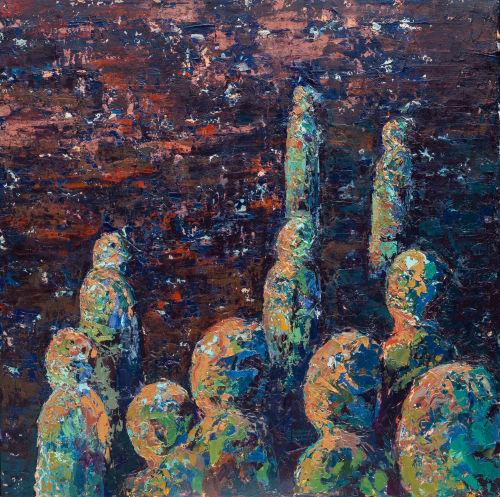Ask and it shall be given,
Seek and ye shall find,
But I have sought and have not found
A treatment for what ails my mind.
I mourn religion’s retreat
Unable to be saved by the Son of Man;
Its impact a morsel of what I need
To repair my mind.
As I stay battling my medications’ decline,
the side effect of pills – a worsened mind?
Heavier body, weaker spirit
dependence on this man made healing.
The spirits of joy do randomly whisper,
as I reach to grab they slip through my fingers.
“we are not here to stay” they say
“enjoy us while you can, for we must drift away”
Who am I?
if not fragmented versions of myself,
seeking freedom from chaos
some semblance of wholeness
refuge from intrusive thoughts
with a weary mind,
and a labored sigh,
if solace exists, when shall mine come by?
—Sabrina Coleman-Pinheiro
Rele Gallery, Lagos is pleased to present Feeling Blue, Seeking Solace, the debut solo exhibition of Sabrina Coleman-Pinheiro. The works presented exist as part of an ongoing dialogue on mental health and mental health issues in contemporary society. Built up with thick layers of paint, Coleman-Pinheiro’s shroud-like figures emerge and recede into shadowy, formless landscapes, silent inhabitants of an unknowable world. These conjured figures, expressionist in their otherworldliness usher us into the unfathomable depths of the human mind, through emotional experiences and murky landscapes.
Echoing the indeterminate, vast nature of the human mind, Coleman-Pinheiro’s textured canvases exist as ‘snapshots’ of an expanding, complex world, one that overwhelms and detaches, offering new depths and realities. In this exhibition, the artist contemplates what it means to find healing and respite from mental trauma. Done primarily in acrylic, the paintings record and communicate fragmented parts of unfolding emotional responses. They offer moments from an ongoing search for relief, presenting solace as a continuous, non-linear process rather than an imagined final state.
The body of work presented here comes at a time when conversations around mental health and wellness are increasingly being had. We find ourselves investigating the storied history and affective relationship between trauma, interpersonal relationships and the environment. How then do we construct processes and spaces of respite from mental trauma? In engaging with the complexly theorised sphere of the mind, how do we imagine procedures of care and destigmatisation?
Coleman-Pinheiro’s scenes are compositionally and texturally chaotic, from images of singular characters to closely packed figures. Yet, they present us with stillness, one prompted by an encounter with the intimate but unfamiliar. We recognise them in form, we might even find ourselves reflected in their silhouetted bodies, but the journey into their experiences and realities has only just begun. The paintings exist as pieces of a larger vista to which we must return in teasing out emotional experiences and responses from bodies going through a journey of healing.

